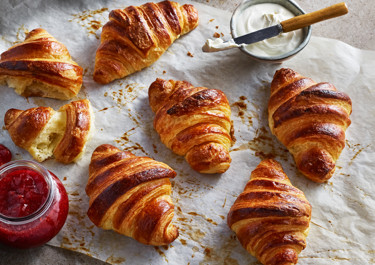Croissants
&format=webp)
Offer a freshly baked croissant when it's time for a luxury breakfast! These crispy and tasty croissants are made with real butter and are unfilled. If you want croissants with filling, you can easily roll in a tablespoon of chocolate cream or apricot jam.
Ingredients
Croissant
|
Butter
|
300 g |
|---|---|
|
Yeast
|
25 g |
|
Arla Cravendale Whole milk
|
250 ml |
|
Egg
|
1 |
|
Salt
|
½ tsp |
|
Caster sugar
|
40 g |
|
Flour
|
380 g |
Egg wash for brushing
|
Egg
|
1 |
|---|---|
|
Water
|
2 tsp |
Instructions
Step 1
Step 2
Step 3
Step 4
Step 5
Step 6
Step 7
Step 8
Step 9
Some excellent serving tips
Croissants are incredibly versatile and can be served with both sweet and savoury combinations. Cut them in half and add scoops of vanilla ice-cream for a simple but incredibly tasty option. Alternatively add fresh berries and brie to further push the sweet-savoury contrast. To go truly French, dip it in some strong coffee as part of your morning routine.
Freeze them for the next day
The best way to freeze croissants is to freeze the dough itself, which will keep for up to six months. That way you simply need to defrost, roll, and warm in the oven for a deliciously fresh breakfast.
Questions about croissants
Croissants can be a delicious treat as a snack or for breakfast. Read below to get to know more about the most frequently asked questions about croissants.
How do you get perfect layers on croissants?
The perfect croissant is said to have as many as 45 layers, and it takes time and skill to get it right. Skilled pastry chefs require years to learn how to deliver a world-beating croissant, but this recipe provides a simple route to a solid result. The key is to let the dough rest for a sufficient amount of time – cutting corners will ruin the outcome. Ideally, you should chill it overnight if possible to ensure a fluffy pastry.
Should croissants be chilled before baking?
Chilling croissant dough is essential, and the true Parisian way to make them involves chilling several times over a period of two days. First the dough is refrigerated for 30 minutes, then it is rolled out into a rectangle, covered and chilled again overnight, before being covered in butter, folded and – you guessed it – chilled again, for 30 more minutes. The laminated dough is then folded once more and allowed to rest for four hours, before being cut, rolled and baked.
Why are my croissants not flaky?
A common culprit for non-flaky croissants is dough or butter that is too warm when carrying out the laminating process. If either of the components aren’t chilled, the butter will melt into the dough and won’t create the flaky layers you want.
How many times should you fold a croissant?
A minimum of three folds is the common principle applied to croissants, though many pastry chefs favour four or more. It all depends on how much patience and time you have.
What flour works best for croissants?
All-purpose flour is fine for making croissants, though pastry chefs often use special T45 pastry flour for the lightest outcome.
How do you get the perfect croissant shape?
A thin triangle shape is deployed then rolled to create the standard croissant, though they haven’t always been crescents. Straight varieties have been around for just as long, though are less common today.
Do you cover croissants when proofing?
Croissants should be covered when proofing to prevent the dough from drying out and undoing the proofing process.
The classic French breakfast croissant
Croissants are strongly associated with France, but they actually originated in 17th century Vienna. The French version didn't appear until almost 200 years later, thanks to baker August Zang. Zang's Viennese patisserie in Paris had a hit with their take on the pastry from his native Austria.
Add these fillings for variation
The simple butter croissant works wonderfully on its own, but there are a number of fillings that can take the pastry to the next level. A thin layer of chocolate or almond paste are two classics, while Nutella is also a big hit with younger audiences. For a satisfying savoury filling, add thinly sliced ham and a slice of Emmental cheese and enjoy!
Mini croissants for a kids’ party
Dividing the dough into smaller triangles allows you to roll miniature croissants that make the perfect-sized treat for a birthday party or other celebration. Add some chocolate chips to truly delight the kids!








